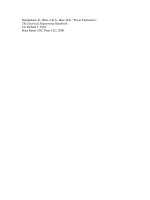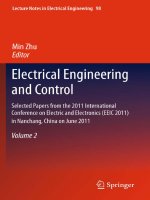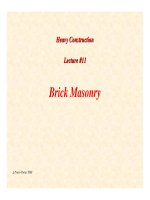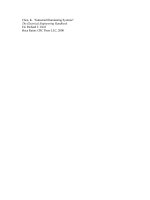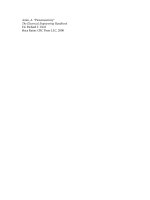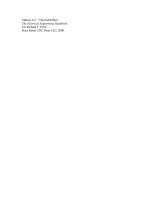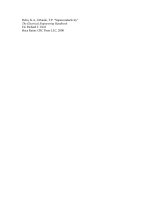Lecture Electrical Engineering: Lecture 11 - Dr. Nasim Zafar
Bạn đang xem bản rút gọn của tài liệu. Xem và tải ngay bản đầy đủ của tài liệu tại đây (1.31 MB, 48 trang )
COMSATS Institute of Information Technology
Virtual campus
Islamabad
Dr. Nasim Zafar
Electronics 1
EEE 231 – BS Electrical Engineering
Fall Semester – 2012
The Diode Applications:
Lecture No: 11
Contents:
Ø
Rectifiers:
• HalfWave Rectifiers
• FullWave Rectifiers
Ø
The Basic Power Supply
Ø
Diode Limiting (Clipping) and Clamping Circuits.
Ø
Switching Diodes
Reference:
Chapter 2 Diode Applications:
Figures are redrawn (with some modifications) from
Electronic Devices
By
Thomas L. Floyd
The Diode Applications:
Lecture No:
12
Applications of PN Junctions:
BJT (Bipolar Junction Transistor)
P
HBT (Heterojunction Bipolar Transistor)
N
Junction Diode
J
U
N
Tunnel Diode
PN Junction Diode
PhotoDiode
C
T
N
Zener Diode
Varactor Diode
Switching Diode
Solar Cell
Photo Detector
Light Emitting diode & Laser Diode
JFET
I
O
Rectifiers
FET (Field Effect Transistor)
MOSFET memory
MESFET HEMT
Common Applications of Diodes:
Rectifier
Zener
LED
Schematic symbol
Bias for normal
operation
Switched back and
forth between forward
and reverse.
Reverse
Forward
Normal VF
Si: VF = 0.7 V
Ge: VF = 0.3 V
VF = 0.7 V (not
normally operated)
1.2V VF
Normal VR
Equal to applied
voltage.
Equal to VZ.
Equal to applied
voltage.
Primary factors to
consider for device
substitution
I0 and VRRM ratings.
PD(max) and VZ
ratings.
VF(min), IF(max), and
VBR
6
4.3V
The Diode Applications:
Objectives:
Ø
Explain and analyze the operation of halfwave rectifiers.
Ø
Ø
Explain and analyze the operation of fullwave rectifiers.
Define a power supply and the main components in a common
linear AC to DC power supply. Explain the purpose and
function of each component.
The Diode Applications:
Objectives:
Ø
Ø
Ø
Define the components that transform pulsating DC into
constant DC. Define ripple and identify its origins.
Understand the operation of diode limiting and clamping
circuits.
Interpret and use a diode data sheet.
The DiodeRectifiers:
Rectifier Circuits:
Ø
HalfWave Rectifier
Ø
FullWave Rectifier
Ø
The Peak Rectifier
9
Rectifier Circuits
Let us consider an Ideal Diode Model for
DiodeRectifierAnalysis
10
Input Signal for Rectifier Circuits:
In the simplified ideal diode case, the input and output wave forms
are as shown below:
The DiodeRectifiers:
Ø One of the important application of a diode is their use in the design of the
rectifiers, which converts an ac signal into a dc signal.
Ø Diodes conduct current only in one direction and block current in the other
direction. Current flows in the forward biased diode. A forwardbiased
diode is said to be turnedon or simply “on”. In a reverse biased diode, no
current flows and the diode behaves as an open circuit. The reverse biased
diode is, thus, said to be cutoff or simply off.
Ø Diodes are thus used in circuits called “Rectifiers” that convert ac voltage
into a dc voltage.
Ø Rectifiers are found in all dc power supplies which operate from an ac
Diode RectifierForward Biased;
Ø
Ø
The simplest form of rectifier is the
half wave rectifier shown. Only the
transformer, rectifier diode, and
load (RL) are shown without the
filter and other components.
During the positive half cycle of the
input signal, the anode of the diode
is positive, thus the diode is
forward biased.
Ø
The diode conducts and acts like a
closed switch letting the positive
pulse of the sine wave to appear
across the load resistor.
Diode RectifierReverse Biased:
Ø
Ø
Ø
During the negative half cycle, the
diode anode will be negative, so the
diode will be reverse biased and no
current will flows.
No negative voltage will appear
across the load. The load voltage
will be zero during the time of the
negative half cycle.
See the waveforms that show the
positive pulses across the load.
These pulses need to be converted
to a constant dc voltage.
HalfWave Rectifier:
Ø
The ideal diode conducts for vi > 0 and
since Rf =0
v0 vi
Ø
For vi < 0 the ideal diode is an open circuit,
(it doesn’t conduct) and
v0 0
HalfWave Rectifier Circuit:
(a)
(b)
HalfWave Rectifier Circuit
Equivalent Circuit of the halfwave rectifier with the diode
replaced with its barrier potentialplusresistance model.
HalfWave Rectifier Output:
(c) Transfer characteristic of the rectifier circuit.
(d) Input and output waveforms, assuming th at
rD
R
Average Value of the Output Voltage (HalfWave) :
In the simplified (ideal diode) case, the input and output
wave forms are as shown below:
Average Value of the Output Voltage (HalfWave) :
Average dc value of this halfwaverectified sine wave is:
VAV
1
2
VM sin d
0
0
VM
cos
2
cos 0
VM
HalfWave Rectifier with a Capacitor Filter:
Ø
Ø
Ø
In the simple diode rectifier circuits shown above, though the output
voltage does not change polarity, it has a lot of ripple, i.e. variations
in the output voltage about a steady value.
To generate an output voltage that resembles a true dc Voltage, we can
use a smoothing capacitor in parallel with the output resistance
(load).
The capacitor does a good job of smoothing the pulses from the
rectifier into a more constant dc.
Ripple:
Ø
Ø
Ø
Ø
A small variation occurs in the dc because the capacitor discharges a small
amount between the positive and negative pulses. Then it recharges. This
variation is called ripple.
The ripple can be reduced further by making the capacitor larger.
The ripple appears to be a saw tooth shaped AC variation riding on the DC
output.
A small amount of ripple can be tolerated in some circuits but the lower the
better.
HalfWave Rectifier with Capacitor+Load Resistor
c03f34
Tin
Ø
Cause of ripple:
Ø
A path is available for capacitor to
discharge.
Therefore, Vout will not be constant
and a ripple exists.
How the Capacitor Filter Works:
Ø
Ø
A large capacitor is
connected across the load
resistor. This capacitor filters
the pulses into a more
constant DC.
When the diode conducts, the
capacitor charges up to the
peak of the sine wave.
How the Capacitor Filter Works:
Ø
Ø
When the sine voltage drops,
the charge on the capacitor
remains. Since the capacitor
is large it forms a long time
constant with the load
resistor. The capacitor
slowly discharges into the
load maintaining a more
constant voltage output.
The next positive pulse
comes along recharging the
capacitor and the process
continues.
An Inverting HalfWave Rectifier:
If Vin >0, D1 and D2 are off.
If Vin <0, D1 and D2 are on
and Vout>0.
